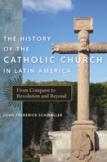Southern Exposure
New York Univ. Press. 336p $35
Having spent the past 40 or so years immersed in books and articles dealing with religion and the church in Latin America, I was surprised to come across John Frederick Schwaller for the first time. He was not a name I was familiar with, but with a little digging I discovered he is a major scholar of 16th-century Mexico and an authority on the Nahuatl language.
He had spent several years with the esteemed Academy of American Franciscan History, worked with the late Antonine Tibesar, O.F.M., and contributed to the academy’s journal, The Americas.
In the 1960s and ’70s, when world attention was being drawn to events challenging the church to the south—today’s human rights movement traces its origins to the persecution by military dictatorships of the church in Brazil, then Chile and elsewhere—the brilliant Argentine historian Enrique Dussel wrote his magisterial A History of the Church in Latin America.
What Professor Schwaller has accomplished in this work is a rather pleasant review of the pre-Columbian civilizations—the classic Maya, the Aztec and the Inca—followed by the Iberian history of the late Middle Ages and the missionary endeavors of the early Spanish Franciscan and Dominican friars in New Spain (Mexico and Central America), the vice-royalty of Peru (western South America) and the Portuguese in Brazil.
This is his area of specialization, and he tells the story well, if a bit superficially. He provides a more detailed account of ecclesiastical offices of the time than one is likely to find anywhere but on Wikipedia and has useful things to say about the mendicant orders’ dependence on charity (or the crown), as contrasted with the Jesuit business enterprises throughout much of the region. The sons of Ignatius, we learn, were “the leading landowners in much of colonial America” before being expelled from the Spanish colonies by the Bourbon reforms in the mid-1700s, as they had been from Brazil by the Portuguese reforms under Pombal.
Turning to Mexico: the 1810 revolution was inspired in large part, according to Schwaller, by Miguel Hidalgo’s belief that “the Church had suffered mightily as a result of the Bourbon reforms.” This may cast a more pious light on this revolutionary priest who fathered children and had himself declared generalissimo of his rebel forces, which led ultimately to his defeat as well as to his own excommunication and execution. But he is revered today as the Father of the Nation.
On reading of the 1882 Colombian concordat with Rome, I was struck by the absolute independence granted the church in matters of the law: the church was to have autonomy from civil jurisdiction, and the ecclesiastical courts would be the sole venue for ecclesiastical cases.
By the second to last of 11 chapters, “The Mid-Twentieth Century Church,” Schwaller enters the period when much of the West looked upon Latin America and its church with either excited enthusiasm or grave concern, depending on where one stood. It is a story that this Nahuatl scholar tried hard to grasp but that finally eluded him.
A number of verbal errors suggest a lack of familiarity with much of the modern history of the church. The name of Leo XIII’s encyclical is always given as “De Rerum Novarum.” A layperson, as contrasted with a cleric, is a “laic.” The author insists on calling episcopal conferences councils but calls CELAM—Consejo Episcopal Latinoamerica-no—a conference. We do not refer to the Holy Spirit as “the third arm of the Trinity,” nor is celibacy one of the three religious vows. Cura animarum does not translate as “cure” of souls but as their care.
Although published this year, most of the book draws on earlier articles and talks. References to important church documents focus on the early social encyclicals and the Second Vatican Council (1962-65). Finally, there are passing references to Medellín (1968) and, ultimately, Puebla (1979), with no mention of Santo Domingo (1992) or Aparecida (2007), much less the Synod of Bishops for America (1997).
More serious are misunderstandings of key events in the recent life of the church. “CELAM played an important role” at Vatican II, Schwaller writes. Not so; very few Latin American bishops besides Dom Helder Câmara spoke up. It was Manuel Larraín, bishop of Talca, Chile, who spoke with Paul VI at the end of the council, proposing that the Latin American bishops convene to consider the application of the council to their region; hence Medellín. The auto accident that took Larraín’s life did not occur “en route to the conference” but while he was traveling from Santiago to Talca in June 1966.
A kind of philo-Protestantism plays out in much of the book. Latin America has historically lagged behind other areas of the church in ecumenical relations, but one winces on reading that in Chile in the 1970s, “nearly a quarter of the population was already Protestant,” but the official 2000 census indicates a drop in the total Protestant population to 15.1 percent, with Catholics at 70 percent. The Committee of Cooperation for Peace in Chile, which was the ecumenical predecessor of Cardinal Raúl Silva’s Vicari-ate of Solidarity, could hardly be described as “an alliance of Lutherans and Jews,” and the truly monumental story of the late 20th-century’s martyrs and confessors is but a minor sidebar here.
One wishes the author had consulted more widely than he seems to have done the excellent works cited in the bibliography.
This article also appeared in print, under the headline “Southern Exposure,” in the May 2, 2011, issue.








